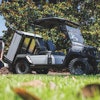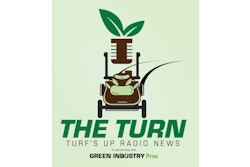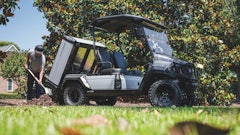
In recent years, the turf industry has witnessed a shift toward electrified equipment, marking a significant departure from traditional gas-powered models, and it's not just about reducing noise pollution in neighborhoods anymore. Equipment owners and operators alike are discovering a compelling set of advantages to going electric. Including cleaner air and environmental sustainability, operational efficiency and reduced maintenance, electric equipment is proving to be a game-changer.
Let's take a deep dive into the world of electrified turf care, exploring the different options currently on the market and the notable benefits that are making electric power the future of the turf care industry. We'll also share some essential insights into taking care of your Lithium-Ion battery-powered equipment to keep your electric fleet running strong, season after season.
The latest in electrified turf equipment
As battery technology continues to advance and the demand for turf care equipment grows, products like dethatchers, leaf blowers, aerators and overseeders are being switched to lithium-Ion battery power. Maximize Market Research found in a May 2023 market report that the turf care equipment market was valued at $11.92 billion in 2022 and is expected to reach $19.9 billion by 2029, exhibiting a compound annual growth rate of 7.6% during the forecast period (2023–2029). Repowering these tools with lithium-Ion battery power is unlocking new capabilities and benefits, including:
- Zero emissions, a pivotal factor in an era where environmental consciousness is paramount.
- Reduced noise footprint, making battery power an appealing choice for leaf blowers and aerators that work in noise-sensitive environments, such as residential areas, schools, hospitals and business parks.
- Little to no required maintenance compared to gas-powered equipment, translating to lower operating costs and increased uptime.
- Cordless operation for enhanced portability and versatility, eliminating tangled cords and expanding the operator’s range of movement.
- Reduced operator fatigue due to lighter and more maneuverable equipment.
Essentials for electric equipment care
As the shift toward electric power continues to transform the world of turf care, equipment owners and operators must understand the best way to care for their lithium-Ion battery-powered equipment. Whether it's for a leaf blower, aerator, dethatcher or overseeder, proper care of the lithium-Ion battery is crucial to ensure optimal performance and longevity.
Charging
One of the most important aspects of lithium-Ion battery care is charging. Lithium-ion batteries can be sensitive to charge cycles, and improper charging can affect their overall lifespan. It is recommended to always use the charger provided by the manufacturer. These chargers are designed to meet the specific needs of the battery and prevent overcharging, a common culprit in battery degradation. Most modern chargers are designed to stop charging once the battery is full, but it's a good practice to unplug the charger when the charging process is complete. When looking to purchase electric equipment, consider equipment powered by a battery that is made with its own charging platform. This usually means there are special safeguards and features built-in to optimize charging and prevent the issues that can come with overcharging.
It's also important to note that lithium-Ion batteries can be charged at any time, regardless of their charge level. Unlike with other battery technologies, there is no need to fully discharge them before recharging. Deeply discharging a lithium-Ion battery can cause it to lose capacity over time and reduce its ability to hold a charge. It's best to keep the battery within a moderate charge range, avoiding both full discharge and continuous overcharging. This flexibility allows more convenient use and helps maintain battery health.
Storage conditions
Storage conditions are just as important as charging for lithium-Ion batteries. Extreme temperatures can have a significant impact on their performance and lifespan. When not in use, battery-powered equipment and its battery should be stored in a cool, dry place, avoiding direct sunlight and areas prone to significant temperature fluctuations. This can help prevent irreversible damage to the battery cells.
Preventive maintenance and firmware and software updates
Though there is limited maintenance associated with lithium-Ion battery-powered equipment, preventive maintenance is still crucial, just like with any piece of equipment. It is important for users to periodically check the battery and equipment for any signs of damage, wear or corrosion. Along with preventative maintenance, users should also be sure to keep their equipment’s software up to date. In today's digital age, some battery-powered equipment comes with smart features and firmware updates. Manufacturers often release updates that address potential issues, enhance battery management systems and optimize power consumption. Keeping equipment's software up to date helps to make sure it operates efficiently.
Following proper use and maintenance guidelines
Finally, it is important to follow the manufacturer's lead. Manufacturer instructions are a user’s best resource for ensuring the proper operation and care of electric equipment. Avoid pushing equipment beyond its recommended limits. Overloading or exceeding its intended workload can put stress on the battery and shorten its lifespan.
The electric future of the turf industry
The shift toward electrified equipment in the turf industry represents a larger trend toward sustainability and efficiency in the compact equipment industry. With benefits such as zero emissions, quieter operation and reduced maintenance, electrified equipment is transforming turf care. Equipment owners and operators are embracing this evolution; not only for environmental reasons but also for the practical advantages it offers. As the industry continues to explore and adopt electrified solutions, it is crucial to prioritize best-care practices for lithium-Ion battery-powered equipment. By following these guidelines—proper charging, storage and maintenance—equipment owners and operators can maximize performance and extend the lifespan of these innovative tools to ensure a greener and more efficient future for the turf care industry.




















